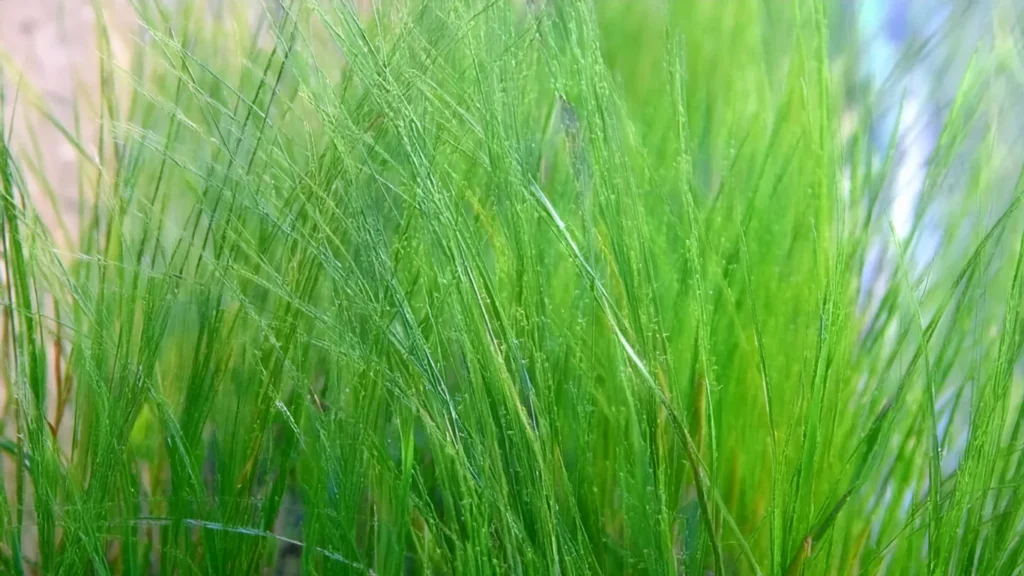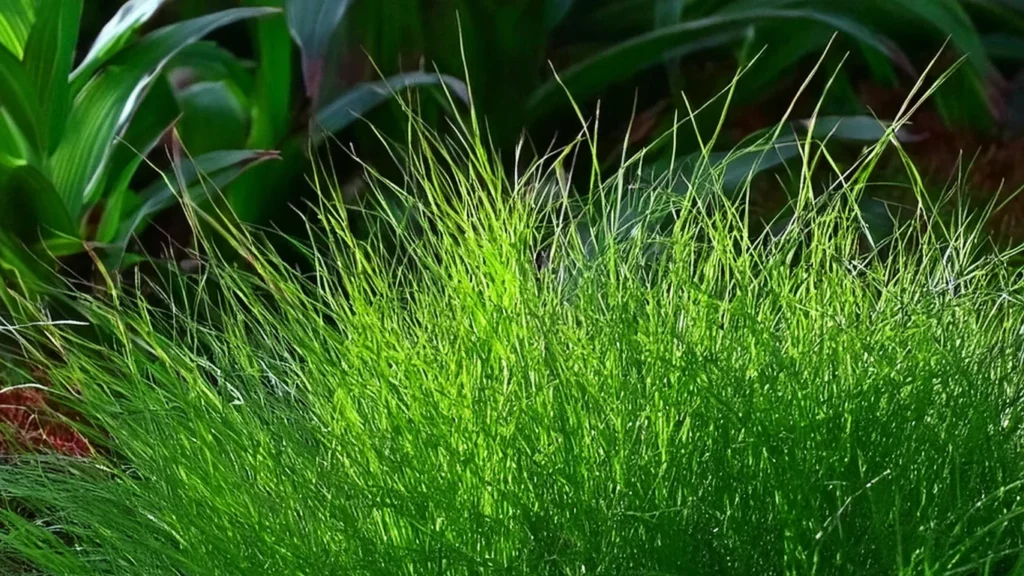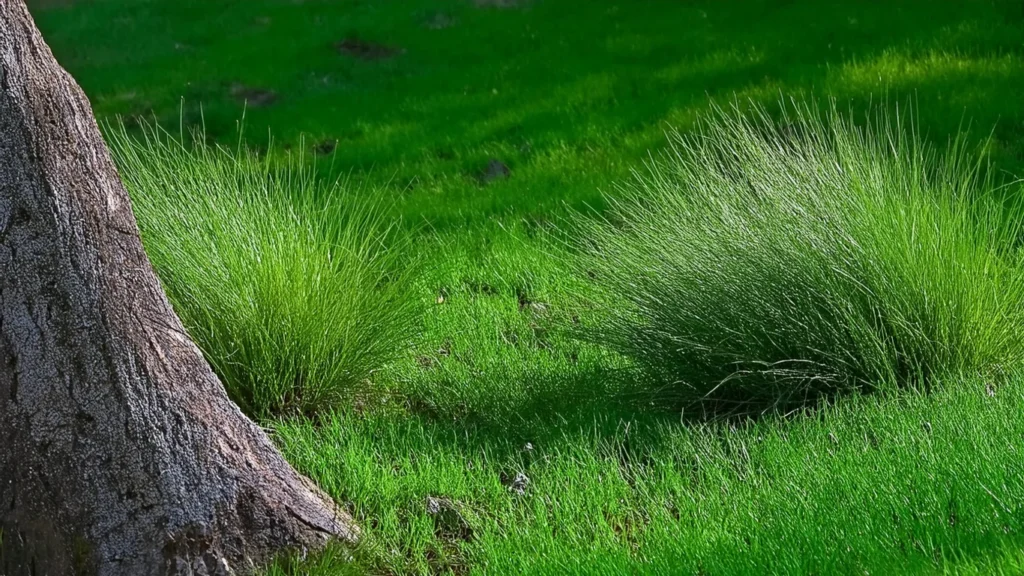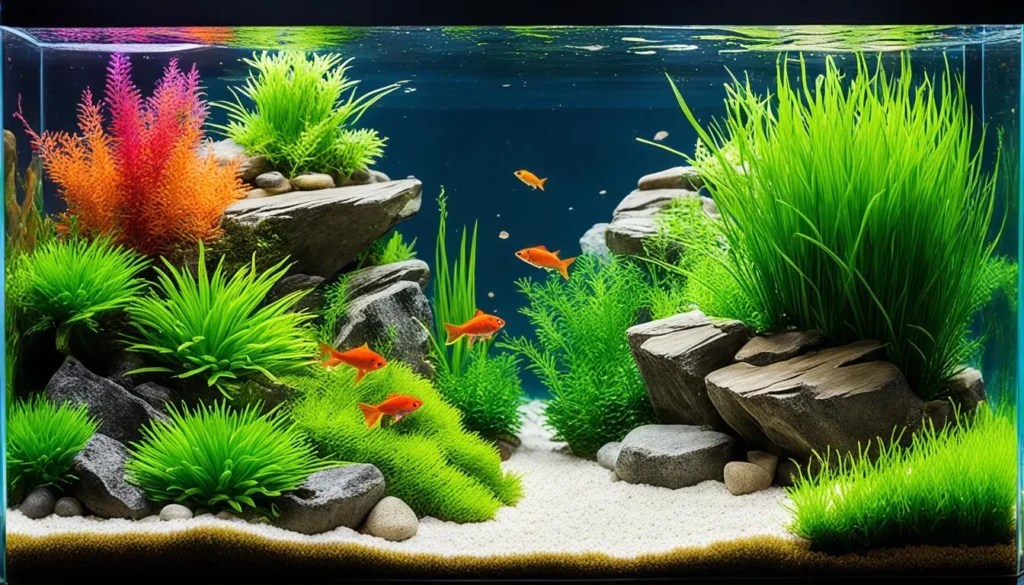Transform your aquarium into a lush, underwater lawn with dwarf hairgrass. Known for its vibrant and verdant appearance, dwarf hairgrass is a popular choice among aquascaping enthusiasts.
This low-maintenance aquarium plant is often used as a carpeting plant to create a beautiful and natural look in freshwater aquariums. Whether you’re a seasoned aquascaping pro or just starting out, dwarf hairgrass will surely add elegance to your underwater oasis.

Key Takeaway
- Dwarf hairgrass is a vibrant and verdant aquatic plant that adds a touch of elegance to your aquarium.
- It is a low-maintenance plant that is ideal for creating lush carpeting in freshwater aquariums.
- Proper planting techniques and maintenance are crucial for its optimal growth.
- Dwarf hairgrass benefits the aquarium ecosystem by providing aesthetic appeal and enhancing oxygenation.
- Pairing dwarf hairgrass with other aquatic plants can create a visually stunning and diverse aquascape.
Quick Stats
| Attribute | Details |
| Family Name | Cyperaceae |
| Origin | Worldwide |
| Height | 2-10 cm (0.8-4 inches), can grow taller in low light |
| pH Range | 6.0 – 7.5 |
| CO2 Requirement | Moderate to High |
| Growth Rate | Moderate to Fast |
| Care Level | Easy to Moderate |
| Color Form | Green |
| Water Conditions | 10-25°C (50-77°F), adaptable to a wide range of hardness |
| Max Size | Leaves up to 10 cm (4 inches) long, typically shorter |
| Lighting | High |
| Supplements | CO2 supplementation enhances growth; root tabs and liquid fertilizers promote lush carpets |
| Placement | Foreground, ideal for creating a carpet effect |
| Propagation | Spreading by runners |
What Is Dwarf Hairgrass?
Dwarf hairgrass, scientifically known as Eleocharis parvula, is a species of grass-like aquatic plant native to North America. It is characterized by its fine, thin leaves that resemble the grass found in meadows, hence the name “hairgrass.”
Dwarf hairgrass is a popular choice for aquascaping due to its versatility and aesthetic appeal. Its small size and carpeting growth habit make it ideal for creating a lush and natural look in aquariums.
Natural Habitat And Origin
Dwarf Hairgrass (Eleocharis parvula) originates from North America, specifically the southeastern United States. It is commonly found in wetlands, marshes, and along the edges of ponds, streams, and rivers.
In its natural habitat, dwarf hairgrass typically grows in moist, sandy or gravelly substrate, often submerged in shallow water. This grass-like plant is well-adapted to environments with fluctuating water levels and can thrive in both submerged and partially submerged conditions.
Physical Characteristic
- Appearance and Growth Habit: Dwarf Hairgrass (Eleocharis parvula) is characterized by its slender, grass-like leaves that grow in dense tufts. It typically reaches a height of 3 to 5 centimeters (1.2 to 2 inches) under optimal conditions. Its fine texture and vibrant green color make it an attractive choice for aquascaping, especially in creating lush carpeting in the foreground of aquariums.
- Versatile Aquatic Plant: Dwarf Hairgrass is a versatile plant suitable for various aquarium setups, from small nano tanks to large aquascapes. Its compact size and ability to form thick mats make it ideal for creating visually appealing landscapes, providing both aesthetic appeal and functional benefits such as oxygenation and habitat for small aquatic creatures.
- Propagation and Maintenance: This plant reproduces through runners, spreading horizontally to cover the substrate. Regular pruning helps maintain its carpet-like appearance and prevents overgrowth. Additionally, providing adequate lighting, CO2 supplementation, and nutrient-rich substrate promotes healthy growth, ensuring a vibrant and thriving carpet of Dwarf Hairgrass in the aquarium.

Lighting Needs For Lush Carpeting
- Proper lighting is essential for photosynthesis and the overall health of dwarf hairgrass. Light provides the energy needed for the plant to grow and thrive.
- For lush carpeting and vibrant growth, it is recommended that 8-10 hours of moderate to high-intensity light be provided daily.
- Full-spectrum LED lights or fluorescent lights with a color temperature between 5000 and 7000K are ideal for promoting the growth of dwarf hairgrass.
- These lights provide the necessary wavelengths for photosynthesis and help maintain the plant’s vibrant color.
Temperature Parameters For Robust Growth
- Tropical Origins: Dwarf Hairgrass, scientifically known as Eleocharis acicularis, originates from tropical regions with warm climates. It thrives in temperatures reminiscent of its natural habitat, typically found in regions like North America, South America, and parts of Europe and Asia.
- Optimal Range: Maintaining a temperature range of 68-82°F (20-28°C) in the aquarium closely mirrors the conditions of its native habitats. This range provides the ideal balance between warmth and stability, essential for promoting vigorous growth and maintaining overall health.
- Metabolic Activity: Temperature profoundly influences the metabolic activity of plants, including Dwarf Hairgrass. Warmer temperatures accelerate metabolic processes such as photosynthesis and nutrient uptake, leading to increased growth rates and vitality. However, excessively high temperatures can also stress the plant and hinder its growth, emphasizing the importance of maintaining the optimal range.
- Seasonal Considerations: In natural environments, Dwarf Hairgrass experiences fluctuations in temperature corresponding to seasonal changes. Mimicking these fluctuations by adjusting aquarium temperature settings can stimulate natural growth cycles and encourage healthy development. For instance, slightly lower temperatures during winter months followed by gradual warming in spring can simulate seasonal growth patterns.
Water Parameters For Thriving Plants
- Temperature: 72-82°F (22-28°C) is the ideal temperature range for dwarf hairgrass.
- pH Level: Maintaining a slightly acidic to neutral pH level between 6.0-7.5 is recommended.
- Water Hardness: Dwarf hairgrass thrives in a moderate to hard water hardness range of 5-15 dGH.
- Clean Water: Regular water changes and proper filtration are necessary to maintain clean water conditions and prevent the accumulation of toxins or waste materials that can hinder the growth of dwarf hairgrass.
- Circulation: Adequate water circulation and flow are essential for distributing nutrients and CO2 throughout the aquarium, ensuring that the dwarf hairgrass receives the necessary elements for growth.

Substrate Requirement
- Grain Size: Dwarf Hairgrass requires a fine-grained substrate to establish its roots effectively and spread runners. Ideally, choose a substrate with a particle size between 1 to 3 millimeters. This fine texture allows the plant’s delicate roots to penetrate easily and anchor securely, promoting healthy growth and development.
- Nutrient-Rich: Opt for a nutrient-rich substrate to provide essential nutrients for Dwarf Hairgrass to thrive. Look for substrates specifically designed for planted aquariums, which often contain beneficial elements like iron, potassium, and trace minerals necessary for plant growth. Alternatively, consider adding root tabs or nutrient-rich supplements to the substrate to ensure a steady supply of nutrients over time.
- Porosity and Aeration: A substrate with good porosity and aeration is crucial for maintaining healthy root development and preventing anaerobic conditions. Choose substrates that promote water circulation and oxygenation to the roots, helping to prevent the accumulation of harmful gases and promoting nutrient uptake. Avoid compacted substrates that hinder root penetration and inhibit plant growth.
Placement Option In The Tank
- Foreground or Midground: Dwarf Hairgrass is typically used as a foreground or midground plant in aquascaping layouts due to its low height and spreading growth habit. Placing it in the foreground or midground allows the grass-like foliage to create a lush carpeting effect, adding depth and dimension to the aquarium layout.
- Flow and Circulation: Consider the flow and circulation patterns within the aquarium when placing Dwarf Hairgrass. Position it in areas with gentle to moderate water movement to prevent debris accumulation and ensure adequate nutrient distribution to the roots. Avoid placing Dwarf Hairgrass directly in the path of strong water currents, which may uproot or damage the delicate foliage.
Aesthetic Considerations: Arrange Dwarf Hairgrass in a visually appealing pattern that complements the overall aquascape design.
Experiment with different layouts, such as straight rows, curved lines, or irregular clusters, to create natural-looking arrangements that enhance the beauty of the aquarium.
Incorporate hardscape elements like rocks or driftwood to create focal points and add visual interest to the Dwarf Hairgrass carpet.

Recommended Tank Size
- Nano Tanks: Dwarf Hairgrass can thrive in smaller aquariums such as nano tanks, which typically have a capacity of 5 to 20 gallons (19 to 76 liters). These smaller tanks are well-suited for creating compact carpeting layouts with Dwarf Hairgrass as the foreground or midground plant.
- Small to Medium Tanks: For larger aquascapes or community tanks, consider using Dwarf Hairgrass in tanks with capacities ranging from 20 to 50 gallons (76 to 189 liters). These tanks provide ample space for creating expansive carpeting arrangements or incorporating Dwarf Hairgrass as part of a mixed planting scheme.
- Large Tanks: In larger aquariums exceeding 50 gallons (189 liters), Dwarf Hairgrass can still be used effectively to create lush carpeting or foreground areas. Larger tanks offer more flexibility in aquascaping layouts and allow for creative experimentation with different plant arrangements and hardscape elements.
Suitable Tank Mates For Dwarf Hairgrass
- Monte Carlo: This delicate and compact plant features small, round leaves that create a lush and carpeted appearance. Its vibrant green color contrasts beautifully with the fine blades of dwarf hairgrass.
- Staurogyne repens: With its dense and bushy growth habit, Staurogyne repens adds volume and depth to the carpeted landscape. Its vibrant foliage complements the texture of dwarf hairgrass, creating a captivating visual display in your aquarium.
RELATED: Dwarf Chain Sword For A Lush Carpet In Your Aquascape
Nutritional Needs Of The Plant
Dwarf Hairgrass (Eleocharis acicularis) requires a balanced supply of both macro and micronutrients to thrive in an aquarium environment. Here’s a breakdown of its nutritional needs:
Macro Nutrients
- Nitrogen (N): Nitrogen is a vital component of chlorophyll, the pigment responsible for photosynthesis in plants. It’s essential for the growth and development of Dwarf Hairgrass. Nitrogen can be supplied to the plant through nitrogen-based fertilizers or by incorporating nitrogen-fixing bacteria into the substrate.
- Phosphorus (P): Phosphorus is crucial for energy transfer within the plant and plays a key role in root development and flowering. It can be supplied through phosphate-containing fertilizers or from fish waste and decaying organic matter in the aquarium.
- Potassium (K): Potassium is involved in various physiological processes in plants, including water and nutrient uptake, enzyme activation, and osmoregulation. Adequate potassium levels promote healthy growth and prevent nutrient deficiencies. Potassium supplements are available in the form of liquid or granular fertilizers.
Micro Nutrients
- Iron (Fe): Iron is an essential micronutrient for Dwarf Hairgrass, as it’s required for chlorophyll synthesis and photosynthesis. Iron deficiency can lead to yellowing of leaves and poor growth. Iron supplements are available in various forms, such as chelated iron or iron-rich substrates.
- Magnesium (Mg): Magnesium is a constituent of chlorophyll and is involved in enzyme activation and carbohydrate metabolism. It’s necessary for maintaining overall plant health and vigor. Magnesium can be supplied through magnesium-containing fertilizers or by using magnesium-rich substrates.
- Trace Elements: Dwarf Hairgrass also requires trace elements such as manganese (Mn), zinc (Zn), copper (Cu), boron (B), and molybdenum (Mo) in small quantities. These elements are essential for various biochemical processes and enzyme functions within the plant.

Cultivating Dwarf Hairgrass At Home
Cultivating Dwarf Hairgrass (Eleocharis acicularis) at home requires careful preparation for growth, planting, and initial care to ensure its successful establishment in an aquarium. Here’s a guide:
Preparation For Growth
- Substrate: Choose a nutrient-rich substrate suitable for planted aquariums. A nutrient-rich substrate provides essential nutrients for plant growth and helps anchor the hairgrass roots. Opt for substrates specifically designed for planted tanks or mix nutrient-rich soil with a layer of gravel or sand.
- Lighting: Provide moderate to high-intensity lighting for Dwarf Hairgrass. Adequate lighting is essential for photosynthesis and healthy growth. Use full-spectrum aquarium LED lights or fluorescent tubes to ensure sufficient light penetration to the bottom of the tank.
- CO2 Injection (optional): Consider supplementing carbon dioxide (CO2) in the aquarium water to enhance plant growth. CO2 injection promotes photosynthesis and can significantly boost Dwarf Hairgrass growth. However, CO2 supplementation is optional and may not be necessary in low-tech setups with sufficient lighting.
RELATED: A Comprehensive Guide To Planting Cryptocoryne Wendtii Tropica
Planting
- Preparation: Trim the hairgrass if necessary to remove any damaged or decaying portions. Gently rinse the plants under running water to remove any debris or contaminants.
- Planting Method: Plant Dwarf Hairgrass in small clusters or spread it evenly across the substrate surface. Use tweezers or planting tools to insert the hairgrass roots into the substrate, ensuring they are securely anchored. Planting in small sections allows for better coverage and prevents overcrowding.
- Spacing: Maintain a distance of a few centimeters between each hairgrass cluster to prevent overcrowding and promote proper growth. Avoid planting Dwarf Hairgrass too densely, as it may inhibit root development and lead to algae issues.
Initial Care
- Water Parameters: Maintain stable water parameters conducive to plant growth. Dwarf Hairgrass thrives in slightly acidic to neutral water with a pH range of 6.5 to 7.5. Ensure adequate water circulation and filtration to prevent the buildup of organic waste.
- Fertilization: Begin a comprehensive fertilization regimen to provide essential nutrients for plant growth. Use a balanced liquid fertilizer or root tabs to supply macro and micronutrients to the substrate. Follow dosing instructions based on the size of your aquarium and plant density.
Algae Control: Monitor the aquarium for signs of algae growth, especially during the initial stages. Perform regular water changes to remove excess nutrients and maintain water quality. Consider adding algae-eating fish or invertebrates to help control algae growth naturally.

Plant Propagation Tips
- Encourage Runners: Ensure adequate lighting, CO2, and nutrients to promote runner formation. Press runner nodes gently into the substrate for root establishment.
- Divide Dense Mats: When Dwarf Hairgrass forms thick mats, carefully divide them into smaller sections, ensuring each division has healthy roots and shoots.
- Trim and Replant: Regularly trim the grass blades to maintain neatness. Replant trimmed portions with healthy roots directly into the substrate using tweezers or planting tools.
Benefits Of Planting Dwarf Hairgrass
- One of the key benefits of dwarf hairgrass is its contribution to ecosystem balance and oxygenation. As a living aquatic plant, it plays a vital role in maintaining a healthy ecosystem.
- When photosynthesizing, dwarf hairgrass absorbs carbon dioxide and releases oxygen, contributing to the oxygenation of the aquarium water.
- This oxygenation benefits the fish and other aquatic organisms by providing them with a clean and oxygen-rich environment to thrive in.
- In addition to its oxygenating properties, dwarf hairgrass also helps to stabilize the ecosystem by absorbing excess nutrients, preventing algae overgrowth, and maintaining water clarity.
- By competing with algae for nutrients, dwarf hairgrass helps to keep the algae population in check, promoting the overall balance of the aquarium.
- Besides its role in ecosystem balance and oxygenation, dwarf hairgrass adds a touch of aesthetic appeal to your aquascape. Its vibrant green color and fine, grass-like leaves create a carpeting effect that mimics the look of a lush meadow.
- This visual element brings a sense of natural beauty and tranquility to your aquarium, making it a visual delight for both the aquarist and the observers.
Common Challenges And Solutions
- To prevent algae overgrowth, maintain consistent and appropriate water parameters. Proper lighting is crucial for the healthy growth of dwarf hairgrass while minimizing algae.
- Make sure to provide adequate lighting for 8-10 hours per day, using full-spectrum LED lights or fluorescent lights with a color temperature of 5000-7000K. Maintaining a proper nutrient balance in your tank will also help prevent excessive algae growth.
- Yellowing leaves can be a sign of nutrient deficiency in dwarf hairgrass. Ensure that your tank has a nutrient-rich substrate and supplement with aquarium fertilizers as needed.

Conclusion
Dwarf hairgrass is an incredible aquatic plant that has the potential to transform your freshwater aquarium completely. Its versatility and aesthetic appeal make it an ideal choice for aquascaping enthusiasts of all levels.
Understanding and meeting its specific growth requirements allows you to create a lush carpeting effect that adds beauty and elegance to your underwater oasis.
Whether you’re just starting in the world of aquascaping or are already an experienced hobbyist, dwarf hairgrass offers a rewarding and captivating addition to your aquarium.
This miniature plant will thrive with proper care and maintenance, creating a vibrant and natural look in your aquascape.
Frequently Asked Questions
How Can I Achieve A Quicker Carpeting Effect With Dwarf Hairgrass In My Oasis Setup?
For rapid carpeting, ensure optimal conditions by increasing CO2 supplementation to 20-30 ppm, providing high-intensity lighting, and using a nutrient-rich substrate. Regular trimming encourages lateral growth, leading to a denser carpet.
Consider using a dry start method to grow the hairgrass emersed before flooding the tank to establish roots faster and reduce initial algae competition.
What Are The Best Practices For Fertilization In A Dwarf Hairgrass Setup To Avoid Nutrient Imbalances?
Implement a balanced fertilization regime that includes macro (NPK – Nitrogen, Phosphorus, Potassium) and micro (iron, magnesium, zinc) nutrients tailored to your specific water conditions and plant density.
Start with recommended dosages from fertilizer products but adjust based on plant response and water testing. Overfertilization can lead to algae blooms, while underfertilization may stunt growth. Weekly water changes of 20-30% can help prevent nutrient buildup.
Can Dwarf Hairgrass Be Grown In Tanks With Strong Water Flow, And How Does It Affect The Carpeting?
Dwarf Hairgrass can tolerate moderate water flow, benefiting its growth by ensuring an even distribution of nutrients and CO2. However, a too strong flow might prevent proper rooting and lead to substrate erosion around the plants.
If using high water flow for specific tank inhabitants, consider using rocks or wood to break the flow or planting hairgrass in sheltered areas.
How Do I Deal With Browning Tips Or Slow Growth In Dwarf Hairgrass Despite Optimal Conditions?
Browning tips can result from micronutrient deficiencies, particularly iron. Ensure your fertilization includes adequate micronutrients. Despite optimal light, CO2, and nutrients, slow growth may indicate substrate compaction or poor root aeration.
Aerating or incorporating a more porous substrate mix can improve root health and growth. Reviewing your lighting spectrum and duration can help; sometimes, plants adapt to a specific light spectrum over time.
What Are Effective Methods For Managing Pest Infestations In A Dwarf Hairgrass Oasis Without Harming The Grass?
Manual removal, careful vacuuming, and introduction of natural predators (like certain types of fish or shrimp) are safe for Dwarf Hairgrass and can manage pests.
For severe infestations, dipping the affected grass in a mild hydrogen peroxide solution (2-3 ml per liter) for a few minutes can eliminate many pests without harming the plant. Always quarantine new plants before introducing them to your tank to prevent pest introduction.
- Unveiling The Wonders Of Riccia Fluitans In Aquascapes - August 7, 2024
- Vallisneria Gigantea Var. Guide To Care And Cultivation At Home - July 31, 2024
- Vesicularia Dubyana Care & Growth Guide Tips For Beginner Gardeners - July 30, 2024
